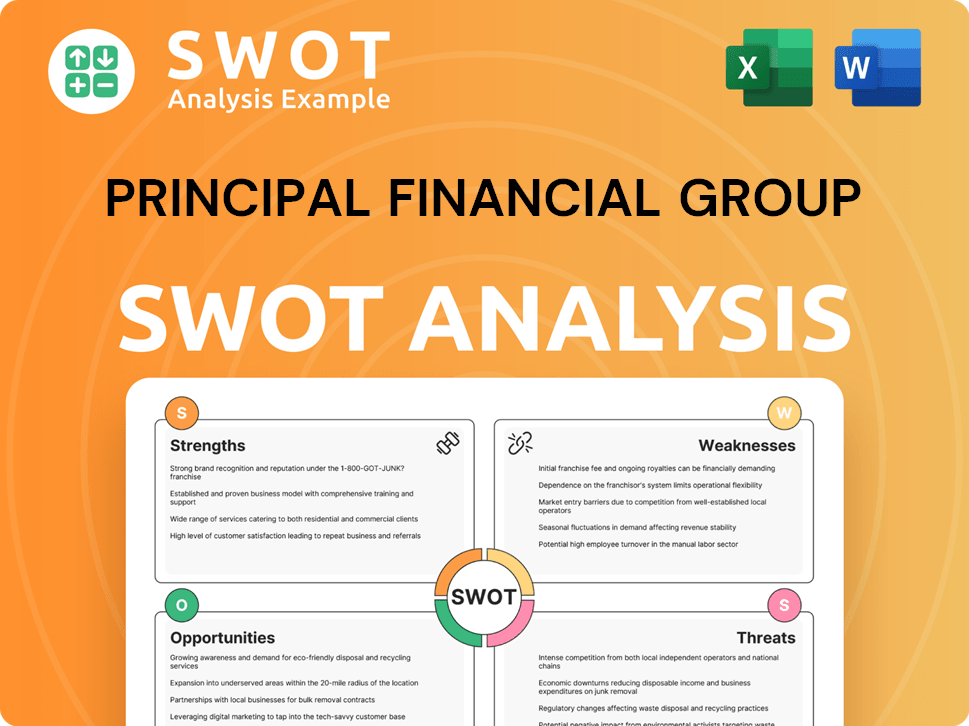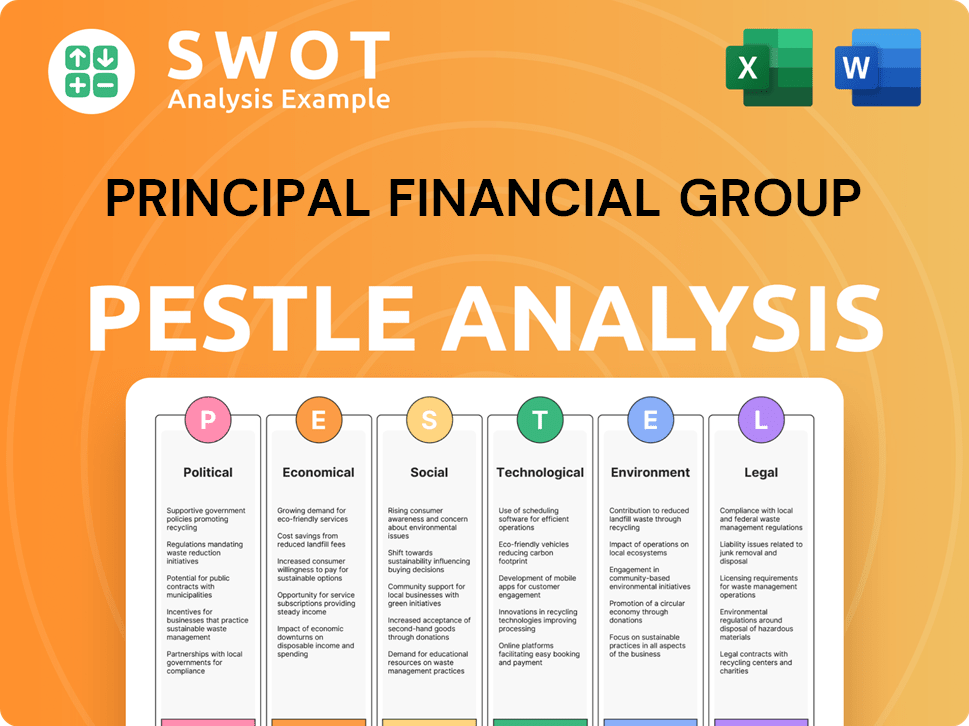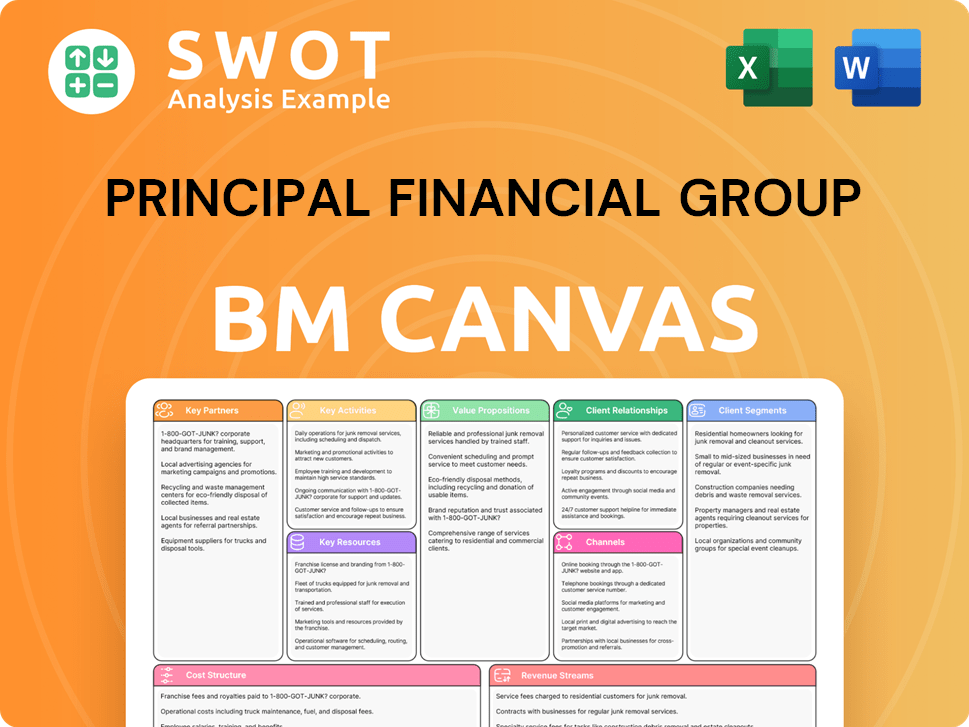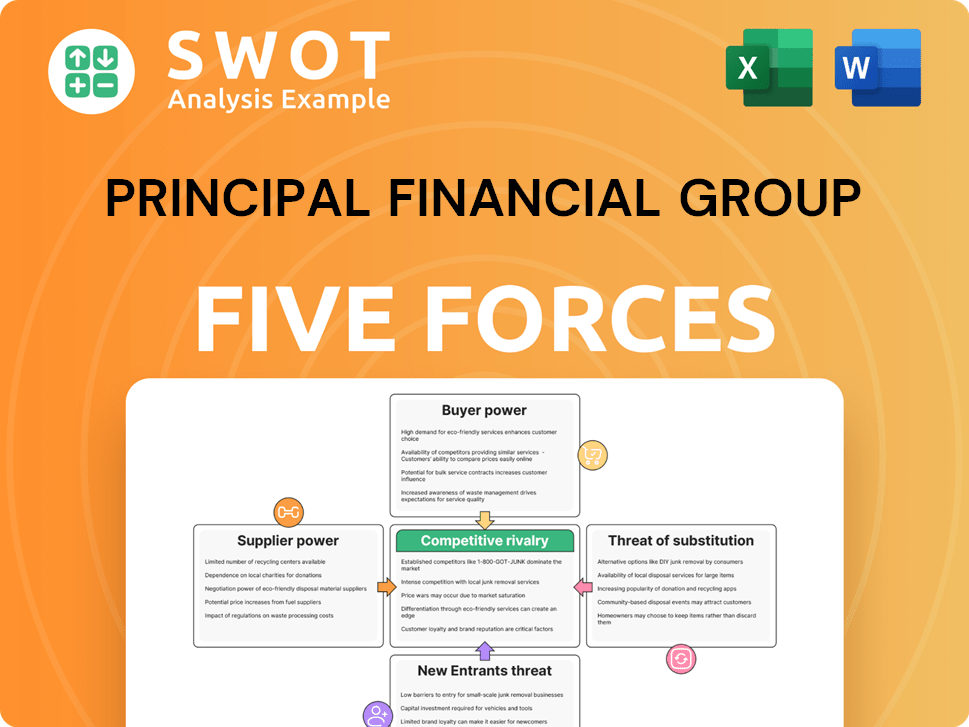Principal Financial Group Bundle
Who Really Owns Principal Financial Group?
Unraveling the ownership of Principal Financial Group is key to understanding its strategic direction and long-term potential. From its humble beginnings in 1879 as the Bankers Life Association, this financial services giant has evolved significantly. Discover the forces that shape Principal Financial Group's decisions and its impact on the market.

This analysis of Principal Financial Group's ownership explores its transformation from a mutual structure to a publicly traded company. Understanding the Principal Financial Group SWOT Analysis can provide insights into the company's position. We'll examine the influence of its shareholders, the role of its board, and the historical context of its evolution, providing a comprehensive overview of who controls this financial powerhouse and its future trajectory. The exploration will cover the Principal Financial parent company, the Principal Financial investors, and the Principal Financial history.
Who Founded Principal Financial Group?
The story of Principal Financial Group, originally known as Bankers Life Association, began in 1879. The company's inception was rooted in a mutual structure, which significantly shaped its ownership model from the outset. This foundational choice meant that the company was owned by its policyholders, not by external shareholders.
This mutual ownership meant there were no traditional founders holding equity in the company. Instead, the 'founders' were the individuals who established the operational framework and governance. Edward A. Temple, the first president, played a key role in the company's early development. The primary goal was to provide financial security and shared prosperity among its members.
The focus of the early operations was to return any profits to policyholders through dividends or reduced premiums. This structure eliminated the need for early investors or equity ownership in the typical sense. Agreements focused on the rights and responsibilities of policyholders, rather than equity-based arrangements. The mutual model reflected a vision of a member-centric financial institution, prioritizing collective benefit over individual profit.
The initial structure of Principal Financial Group was designed to benefit policyholders. This framework ensured that profits were distributed back to the members.
Principal Financial Group started as a mutual insurance company. This meant that the policyholders were the owners.
The founders aimed to create a financial institution centered on member benefits. This vision shaped the company's early operations and ownership model.
Edward A. Temple, as the first president, was a key figure in establishing the company. His leadership helped set the direction for the organization.
Early agreements focused on the rights and responsibilities of policyholders. These agreements were critical to the company's operation.
Because of the mutual structure, there were no early investors or shareholders. This model was central to the company's founding.
The initial structure of Principal Financial Group, a mutual company, meant that its ownership was vested in its policyholders. This model, established in 1879, prioritized the collective benefit of its members over individual profit. The founders, including Edward A. Temple, focused on creating a financially secure environment for its members. This approach is further discussed in the Growth Strategy of Principal Financial Group. As of 2024, the company continues to operate with a focus on its customers and stakeholders, reflecting its historical commitment to financial security and shared prosperity.
Principal Financial Group SWOT Analysis
- Complete SWOT Breakdown
- Fully Customizable
- Editable in Excel & Word
- Professional Formatting
- Investor-Ready Format

How Has Principal Financial Group’s Ownership Changed Over Time?
The most significant shift in the ownership structure of Principal Financial Group occurred in 2001 with its demutualization and subsequent initial public offering (IPO). This transition changed the company from being owned by policyholders to being publicly traded. The IPO was valued at approximately $2.1 billion, marking a pivotal moment in the company's Principal Financial ownership evolution. This change facilitated more efficient capital raising and supported the expansion of its operations.
Following the IPO, Principal Financial Group's ownership has been largely held by institutional investors. These investors, including mutual funds and index funds, represent a broad base of individual investors and retirement savers. The shift to public ownership has enabled Principal to expand its product offerings and global reach, but also subjects it to the scrutiny and demands of public markets and shareholders. Understanding who owns Principal Financial is crucial for investors and stakeholders alike.
| Shareholder | Percentage of Shares (as of Q1 2025) | Type |
|---|---|---|
| Vanguard Group Inc. | 12.01% | Institutional |
| BlackRock Inc. | 9.61% | Institutional |
| Capital Research Global Investors | 5.09% | Institutional |
The collective influence of these large asset managers is substantial, impacting company strategy and governance through their voting power. Other significant institutional holders include State Street Corp., JPMorgan Chase & Co., and Geode Capital Management LLC. While no single individual or family maintains a controlling stake, the ownership structure is heavily influenced by these institutional investors. If you're interested in the competitive environment, you can explore the Competitors Landscape of Principal Financial Group.
Principal Financial Group transitioned from policyholder ownership to a publicly traded company in 2001.
- Institutional investors, such as Vanguard and BlackRock, are the major shareholders.
- The IPO was valued at approximately $2.1 billion.
- The ownership structure impacts company strategy and governance.
- Understanding Principal Financial ownership is essential for stakeholders.
Principal Financial Group PESTLE Analysis
- Covers All 6 PESTLE Categories
- No Research Needed – Save Hours of Work
- Built by Experts, Trusted by Consultants
- Instant Download, Ready to Use
- 100% Editable, Fully Customizable

Who Sits on Principal Financial Group’s Board?
The current Board of Directors of Principal Financial Group includes a diverse group of individuals. Many of them are independent directors, which is a common practice for publicly traded companies. As of early 2025, the board includes members like Daniel Houston (Chairman, President, and CEO), Sandra Helton, and Michael Spellacy.
These directors bring a range of expertise to the table. Their diverse backgrounds contribute to effective governance. The board aims for a balance of expertise and independence, ensuring good oversight of the company's operations. Their collective experience helps guide Principal Financial Group's strategic direction.
| Director | Title | Affiliation |
|---|---|---|
| Daniel Houston | Chairman, President, and CEO | Principal Financial Group |
| Sandra Helton | Director | Various |
| Michael Spellacy | Director | Various |
Principal Financial Group operates under a one-share-one-vote structure, meaning each common share has equal voting rights. This structure promotes accountability to all shareholders. The company's governance emphasizes shareholder value. The board oversees executive performance and strategic direction. This approach aligns with the interests of its broad base of shareholders. For more insights, you can read about the Target Market of Principal Financial Group.
Principal Financial Group uses a one-share-one-vote system. This means each share has equal voting rights. There are no special voting rights that give outsized control to any entity.
- One-share-one-vote structure.
- No dual-class shares.
- Focus on shareholder value.
- Board oversees strategic direction.
Principal Financial Group Business Model Canvas
- Complete 9-Block Business Model Canvas
- Effortlessly Communicate Your Business Strategy
- Investor-Ready BMC Format
- 100% Editable and Customizable
- Clear and Structured Layout

What Recent Changes Have Shaped Principal Financial Group’s Ownership Landscape?
Over the past few years, the ownership structure of Principal Financial Group has remained relatively stable, with a strong presence of institutional investors. There have been no major shifts in ownership due to significant share buybacks or secondary offerings. However, the company has strategically adjusted its portfolio through acquisitions and divestitures. For instance, in 2021, the company sold its U.S. retail fixed annuity and universal life insurance businesses and in 2022, its Chilean pension business, which has streamlined operations and potentially impacted its investor base.
The trend of increasing institutional ownership is common in the financial sector, and Principal Financial Group aligns with this pattern. Large asset managers hold substantial stakes in the company. Founder ownership is negligible due to the company's long history since demutualization. There are no public indications of privatization or changes to its public listing status. Principal Financial Group continues to focus on organic growth and strategic partnerships within its core business areas of retirement, asset management, and specialty benefits, serving a diverse client base. To understand more about the company's strategic direction, you can read about the Growth Strategy of Principal Financial Group.
| Metric | Data | Source/Year |
|---|---|---|
| Institutional Ownership | Approximately 70-80% | Recent filings, 2024 |
| Market Capitalization | Around $20-25 billion | Recent market data, 2024 |
| Revenue | Approximately $14-16 billion annually | Company reports, 2023 |
The company's focus remains on its core business areas. The company's stock price has fluctuated, reflecting market conditions and overall investor sentiment in the financial sector. The company has a diverse shareholder base, including both institutional and retail investors. There are no plans for significant changes to its ownership structure. The company's headquarters are located in Des Moines, Iowa.
Principal Financial Group's major investors include large institutional asset managers. These investors hold significant stakes in the company's stock. Their investment decisions influence the stock's performance and the company's strategic direction.
The ownership structure of Principal Financial Group has been relatively stable. There have been no major shifts in ownership in recent years. The company's focus on organic growth and strategic partnerships reflects this stability.
Principal Financial Group has divested certain businesses to streamline its operations. These moves include the sale of its U.S. retail fixed annuity and universal life insurance businesses. These strategic decisions have impacted the company's focus.
The stock price of Principal Financial Group reflects market conditions. The company's financial performance is influenced by the overall investor sentiment. The company continues to adapt to market changes.
Principal Financial Group Porter's Five Forces Analysis
- Covers All 5 Competitive Forces in Detail
- Structured for Consultants, Students, and Founders
- 100% Editable in Microsoft Word & Excel
- Instant Digital Download – Use Immediately
- Compatible with Mac & PC – Fully Unlocked

Related Blogs
- What are Mission Vision & Core Values of Principal Financial Group Company?
- What is Competitive Landscape of Principal Financial Group Company?
- What is Growth Strategy and Future Prospects of Principal Financial Group Company?
- How Does Principal Financial Group Company Work?
- What is Sales and Marketing Strategy of Principal Financial Group Company?
- What is Brief History of Principal Financial Group Company?
- What is Customer Demographics and Target Market of Principal Financial Group Company?
Disclaimer
All information, articles, and product details provided on this website are for general informational and educational purposes only. We do not claim any ownership over, nor do we intend to infringe upon, any trademarks, copyrights, logos, brand names, or other intellectual property mentioned or depicted on this site. Such intellectual property remains the property of its respective owners, and any references here are made solely for identification or informational purposes, without implying any affiliation, endorsement, or partnership.
We make no representations or warranties, express or implied, regarding the accuracy, completeness, or suitability of any content or products presented. Nothing on this website should be construed as legal, tax, investment, financial, medical, or other professional advice. In addition, no part of this site—including articles or product references—constitutes a solicitation, recommendation, endorsement, advertisement, or offer to buy or sell any securities, franchises, or other financial instruments, particularly in jurisdictions where such activity would be unlawful.
All content is of a general nature and may not address the specific circumstances of any individual or entity. It is not a substitute for professional advice or services. Any actions you take based on the information provided here are strictly at your own risk. You accept full responsibility for any decisions or outcomes arising from your use of this website and agree to release us from any liability in connection with your use of, or reliance upon, the content or products found herein.